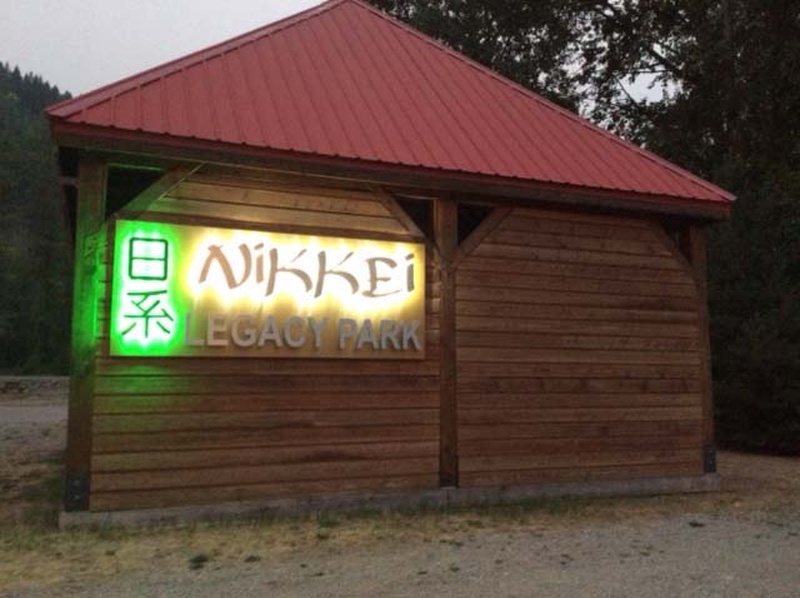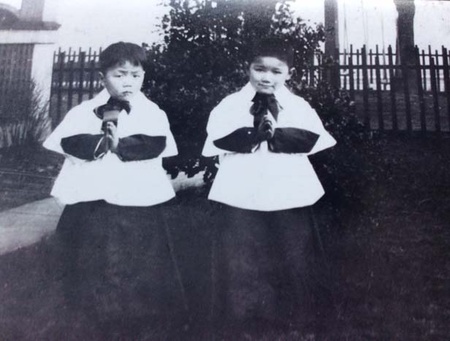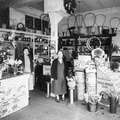Back in 1971, then Prime Minister Pierre Elliott Trudeau declared that Canada would adopt a multicultural policy that recognizes and respects a diversity of languages, customs and religion. In 2015, Trudeau's son Justin, who also became Prime Minister, stated that “Diversity is Canada’s Strength” and over the past few years, there has been a push to encourage inclusion of all ethnic communities.
In British Columbia, the provincial government initiated a project to recognize the accomplishments of once marginalized ethnic groups, including new historical markers and signage. In 2016, road signage marking numerous Chinese Canadian historical sites was completed, at locations such as the Barkerville gold rush era Chinatown, the coal mining community of Cumberland, and the railroad terminal of Craigehallachie. Following that, the province worked towards recognizing a series of Japanese Canadian historic sites. Out of a list of three hundred locations where Japanese Canadians lived and worked, 56 sites were selected and approved for the inclusion on the B.C. Register of Historic Places for contribution made by Canadians of Japanese descent to the economic, social, and cultural development of the province of B.C. There were ten official internment camps including self-supporting sites like East Lillooet, Grand Forks and Christina Lake. Self-supporting sites were established by the B.C. Security Commission for Japanese Canadian families who could afford to pay for their own incarceration so that they could keep the families together.
Eight key areas were selected to have roadside interpretive signage erected. Tashme unveiled their signs in October 2017, followed by signage marking a cluster of self-supporting camps near East Lillooet, including Bridge River, Minto, McGillvray Falls, and Taylor Lake, which were unveiled in May 2018. In June 2018, the third, fourth, and fifth unveilings of signs marking former WWII internment camps took place at the West Kootenay towns of Slocan-New Denver-Kaslo. The Slocan cluster of historically significant sites included Lemon Creek, Popoff, and Bay Farm. The New Denver cluster included Rosebery, Sandon, Nelson, and Harris Ranch. The Jasper/Yellowhead road camp signage unveiling took place on June 23rd spearheaded by NAJC (National Association of Japanese Canadians). In July, the last cluster of towns that were former internment camps unveiled their sign in Greenwood that included self-supporting sites of Grand Forks and Christina Lake. Midway was not an official internment location but it was included. When Kaslo closed its camp, several families were sent to Midway. The last two unveilings of road camp signage will take place in September 2018 at Hope/Princeton and Revelstoke/Sicamous.
Tashme, 14 miles east of Hope, was just outside the 100-mile Exclusion Zone, and was the largest camp, with over 2600 internees. In comparison, Tule Lake, California had over 18,000 prisoners and Poston, Arizona held 17,000 detainees. Over 110,000 Japanese Americans were removed from the West Coast, compared to about 22,000 Japanese Canadians in B.C. Just Tule Lake concentration camp alone had more internees than all of the camps in B.C. combined.
One famous Tashme-an of note is Robert Ito, who was originally a child tap dancer in Vancouver, but his family was relocated to Tashme internment camp in 1942 and later moved to the province of Manitoba. Later, Mr. Ito made it into the Ballet of Canada in Winnipeg. As a young, aspiring dancer, Ito moved to Hollywood, but he ended up as an actor and became famous in the role of Sam Fujiyama, a forensic technician, in the TV series ‘Quincy M.E.' and as naval officer Genda in the movie ‘Midway.’ In Vancouver before the war, Ito was an altar boy at the Vancouver Japanese Catholic Mission, and most JC Catholics were to go to the first internment location of Greenwood. However, the Ito family chose to move to Tashme instead.
Tashme was long forgotten after the war, and eventually the area was developed into Sunshine Valley RV resort. A few years back, Ryan Ellan, a non-Nikkei, bought a cabin in Tashme and soon found out that it was an old internment camp butcher shop. As he was renovating, Ryan found many Japanese Canadian artifacts. The next step he took was to create a Tashme internment museum. With the help of the Nikkei Museum in Burnaby, his idea became a reality. The Tashme Museum became so popular that Ryan expanded by building a replica internment barrack from scratch. He also bought a former Sunday school and kindergarten cabin for a dollar. Moreover, Ryan bought the former Royal Canadian Mounted Police office. It is so wonderful to have Ryan revive the history of Tashme. As fate has it, Ryan grew up with Nikkei children in the fishing village of Steveston. I joked that he isn’t a true Steveston-ite unless he ate okai-yu and shiomon, rice broth and salted salmon. That was a common meal eaten frequently by Nikkei families.
The East Lillooet area, along with Grand Forks and Christina Lake, were called ‘self-supporting’ camps. E. Lillooet was especially challenging because internees had to build their own accommodation, flumes for irrigation, dig a well for drinking water, and make do without electricity so that they could keep their families together.
Esumatsu Nakatani, a lay minister, brought over 300 internees to work the farms in Grand Forks. The Hamagami family went ahead to get Alpine Inn ready for over 100 self-supporting internees. A few worked for Sandner’s Shingle Mill, but most had to find employment in Grand Forks, Greenwood, or Midway.
B.C.'s Security Commission also leased farmers’ fields to create the Lemon Creek, Popoff and Bay Farm camps. New Denver settled in a place called the ‘Orchard.’ Raymond Moriyama’s family should have gone to Greenwood since his mother was a member of the Vancouver Japanese Catholic Mission. Instead, Mrs. Moriyama went to New Denver and Mr. Moriyama was sent to POW camp in Ontario. Raymond became a famous architect who designed the Canadian War Museum in Ottawa and the Canadian Embassy in Tokyo.
Kaslo and Greenwood were boom/bust mining towns in the early 1900’s that had many empty buildings, therefore both sites were filled by the internees in 1942. Japanese Canadian men, ages 18-45, were sent to road camps. As a result, families were split up. Therefore, many Nikkei families chose to work in the sugar beet farms in the province of Alberta and Manitoba just to keep their families together.
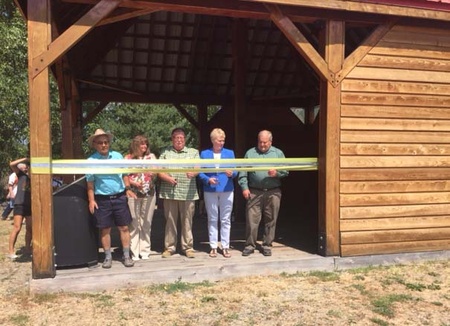
Greenwood’s commemorative signage unveiling and ribbon-cutting ceremony took place on July 29th, 2018. The panel explained how and why Greenwood became the first internment site and the ribbon-cutting was for the local Nikkei Legacy Park display of some 80 family plaques of Nikkei and Caucasian families titled “We Lived Together.” The signage will add an educational component, but more importantly, it will give closure to those aging Nisei who were impacted the most. Many of them were denied high school proms, university graduation, and steady employment in 1942. As for the Nikkei Legacy Park, the family plaques will encourage former residents to return to their ‘furusato’ and pass on the legacy of their families to their grandchildren and great- grandchildren.
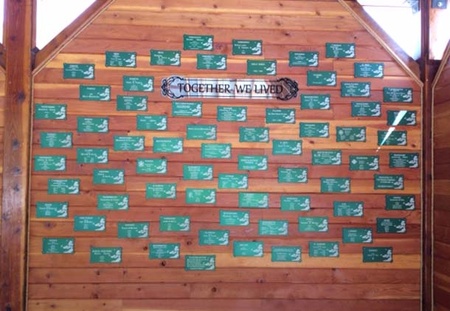
Greenwood was unique from all other internment camps in B.C. In 1942, the City of Greenwood suffered from a dwindling population of about 200, so Mayor W.E. McArthur Sr. wrote an ad in the paper declaring that “Greenwood will not refuse to accept the Japanese Canadians.” Franciscan Friar Benedict Quigley was instrumental in bringing the mostly Catholic JCs to this community. Sacred Heart School began almost immediately, when other camps had to wait nearly a year to offer education opportunities to the internees. The SHS operated in shifts to accommodate its nearly 400 ‘new’ students. Madeline Bock and Grace Namba, who worked for the Women’s Missionary Society under United Church organization, started the kindergarten. As Ms. Bock and Ms. Namba were planning to have upper grades, Greenwood Public School was able to accept some of the Japanese Canadian students.
After the war, Greenwood Nikkei residents were not pressured to relocate again when the government enforced the “Go East of the Rockies or ‘Repatriate to Japan” ultimatum. In fact, the City Hall and Board of Trade wrote a letter of protest against this ultimatum, to keep the Japanese Canadians in the community. Thus, many hundreds made Greenwood their hometown. Some historians stated that there was no ‘Japan Town’ in Canada after the war. Greenwood could have been classified as ‘Japan Town’ with the Nikkei population being the majority. To this day, there are still about 25-30 Nikkei living in Greenwood. Aya Higashi was the last Nikkei to live in Kaslo. There are but a few JCs living in New Denver.
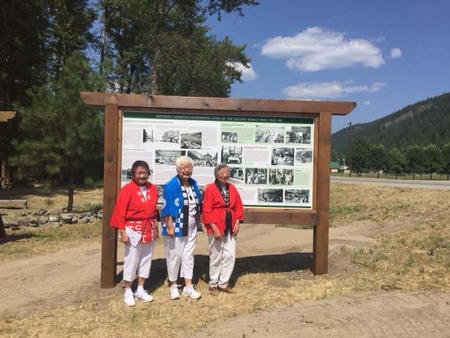
The overflowing crowd enjoyed the afternoon with laughter and tears. It was great to see old friends hugging and reminiscing about their time in Greenwood, Grand Forks, Christina Lake, and Midway. There were tears from former internees as they read the text on the signage. Yamabiko Taiko of Kelowna and local singer Dave Jackson entertained the standing room only crowd at McArthur Centre. Many took interest in the photo display on the wall. Kootenay West MLA (Member of the Legislative Assembly) Katrine Conroy went out of her way on a Sunday to attend, and read aloud Minister of Transportation and Infrastructure Claire Trevena’s letter that it was not a proud time for the government, but the signage will hopefully make people aware of the fragility of democracy and civil liberties. Everett Baker represented Boundary-Similkameen MLA Linda Larson, who happened to be in Japan that day. Greenwood Mayor Ed Smith welcomed everyone.
There were so many out-of-town guests that day. Reporter Naomi Mishima of Vancouver Shinpo wrote an article in the Japanese paper to give more awareness of the Nikkei history in Canada to the shin-ijusha readers. City of Greenwood was praised for being the first community to accept the Japanese Canadians. It was said that New Denver was the last internment camp to close. I suppose Greenwood never closed. It became a community.
© 2018 Chuck Tasaka


